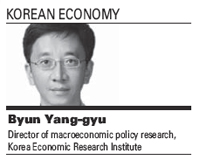Are we about face deflation?
Korea’s gross domestic product (GDP) in the second quarter grew only 2.4 percent on a year-on-year basis, hitting a record low since the third quarter of 2009. Private consumption, which accounts for more than half of GDP, has grown only 1.2 percent over the same period. Investment measured by total fixed capital formation is even worse. It shrunk by 2.9 percent last quarter.
Investment is not the only thing that has plummeted. Exports, which have been the growth engine of the Korean economy, fell by 8.8 percent in July, and what really alarms us is that exports to EU have taken a nosedive, decreasing by more than 15 percent this year. According to recent forecasts by Korea Economic Research Institute, GDP will only rise 2.6 percent in 2012. Korea’s recovery from the effect of the European crisis seems to be in the very distant future.
What really makes us concerned is that the risk of deflation is higher than usual. Deflation, by definition, is a continuous decrease in the general price level of goods and services. During deflation, lending and investments may be shelved because cash holdings are seen as more attractive. In a worst-case scenario, deflation reduces production, which in turn lowers wages and demand for goods and services, leading to further deflation. A vicious circle we call the deflationary circle can happen. Fortunately, the growth rate of the Consumer Price Index (CPI) has never been below zero, and deflation has not officially occurred in our territory.
However, the deflationary circle may indeed happen even when the CPI does not fall. In the event that the general price level grows at a much lower rate than everyone expects, we will be in trouble. For example, consider a scenario in which real estate prices fall even when the CPI grows mildly. People may take out a loan at a high interest rate to finance a real estate purchase because they believe real estate prices will skyrocket which can give them large capital gains. What would happen if real estate prices stay much lower than expected? As the actual burden of repayment increases, people who don’t have sufficient capability to repay their loans start selling real estates, which would end up leading to a further decrease in real estate prices. A problem exacerbates its own cause, and the vicious circle starts. This is the type of debt deflation emphasized by Hyman Minsky in the 1980s.
Now consider where we stand. Korea’s household debt has soared to higher than 900 trillion won, and the mortgage late payment rate, which was 0.62 percent in May last year, rose to 0.85 percent this May. To make things even worse, the price of large-size apartment in the Seoul metropolitan area has dropped by about 13 percent on average since the year 2008, and by more than 40 percent in some areas even during the period when the general price level was rising mildly. We may find signs of deflation elsewhere. The M2 money multiplier has dropped to 22, reaching the lowest level since January 2000. The bank deposit circulation rate is decreasing recently, and long term interest rates are lower than CD rates since April 2012, reflecting gloomy economic forecasts. Furthermore, the IMF deflation vulnerability index, which shows the probability of deflation, has increased from a ‘minimal’ to a ‘moderate’ level since the second quarter of 2011. We might be really facing deflation.
Some argue that the chance of deflation is slim because we expect price increases in some manufacturing goods, electricity and some public services. However, remember that when an economy is in recession and prices go up because of supply shortages and cost hikes, there is a higher chance of stagflation, not a lower risk of deflation.
Stability in the real estate market is a necessity for boosting domestic demand. Household debt must be not only downsized but also must become compositionally healthy. Now it’s time to take a closer look at the domestic markets. <The Korea Times/Byun Yang-gyu>





